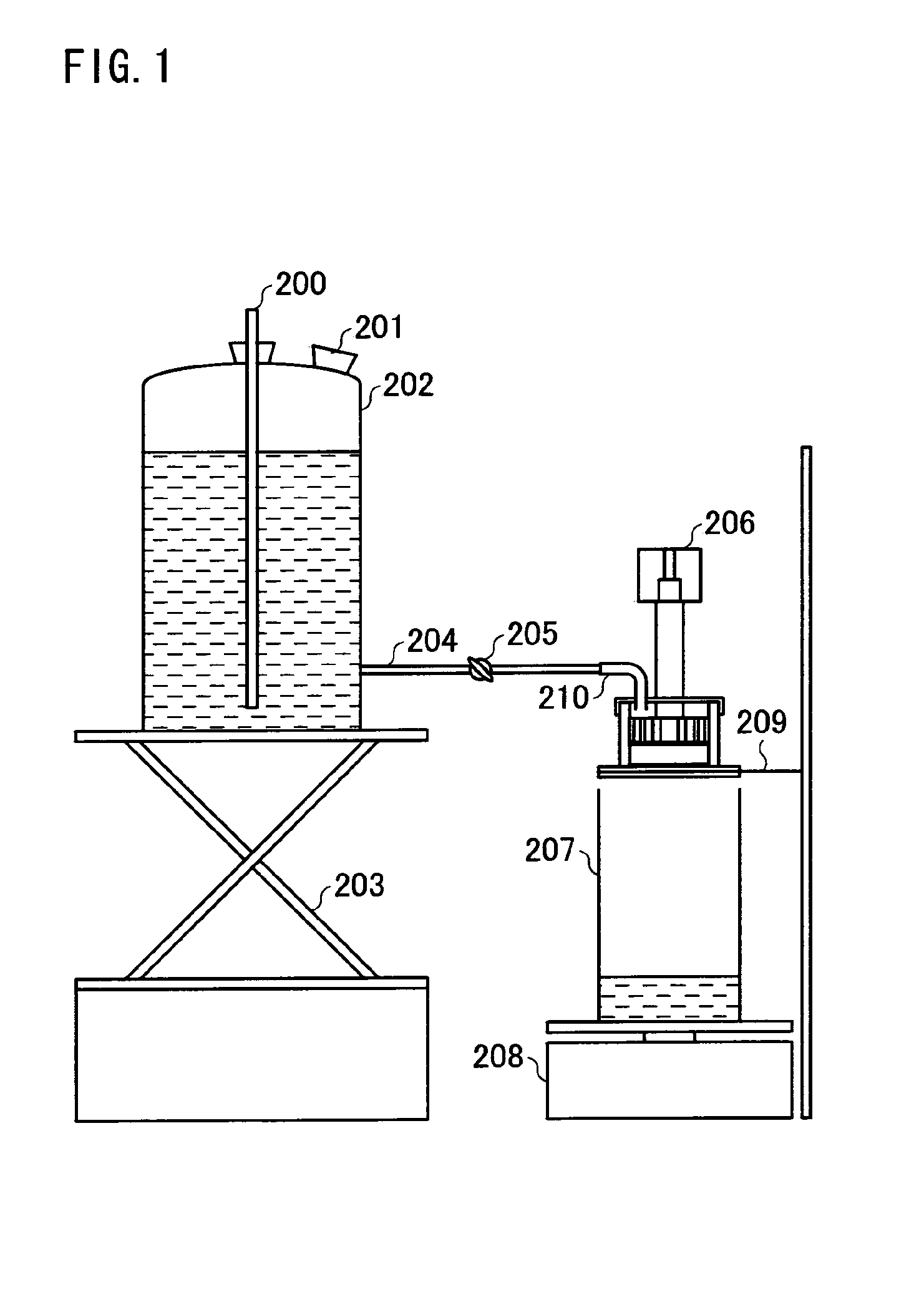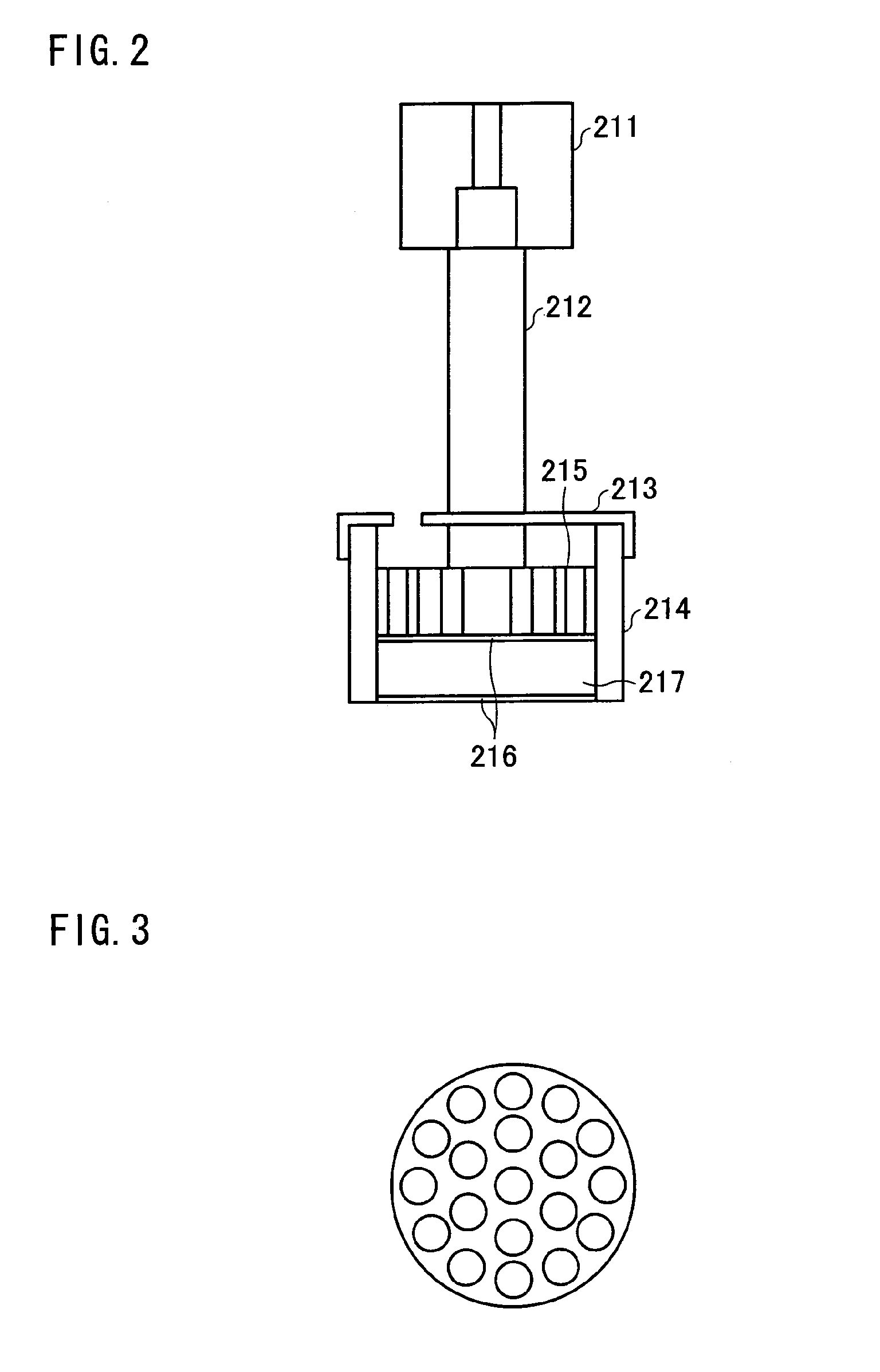Water-absorbing agent and method for producing the same
a technology of water-absorbing agent and water-absorbing pad, which is applied in the direction of absorbent pads, pharmaceutical delivery mechanisms, bandages, etc., can solve the problems of drop in centrifuge retention capacity (crc) and other problems, and achieve excellent liquid permeability and sanitary effects
- Summary
- Abstract
- Description
- Claims
- Application Information
AI Technical Summary
Benefits of technology
Problems solved by technology
Method used
Image
Examples
example 1
[0213]In a polypropylene receptacle of 1 litter in capacity, a solution (A) was prepared by mixing 373.14 g of acrylic acid, 8.11 g of polyethylene glycol diacrylate (molecular weight 523), and 2.25 g of 1.0 mass % diethylenetriamine 5 acetic acid 3 sodium aqueous solution. Furthermore, a solution (B) was prepared by mixing 288.27 g of 48.5 mass % sodium hydroxide aqueous solution and 309.92 g of deionized water (ion-exchanged water) adjusted to have a temperature of 50° C. The solution (B) was quickly added to and mixed with the solution (A) while stirring the solution (A) with a magnetic stirrer, thus a monomer aqueous solution (C) was obtained.
[0214]The monomer aqueous solution (C) raised its temperature up to 102° C. due to heat of neutralization and heat of dissolution. 4.50 g of polyethylene glycol 6000 (average molecular weight 6000, produced by KANTO CHEMICAL CO., INC.) was added to the monomer aqueous solution (C) while stirring the monomer aqueous solution (C), thus a mono...
example 2
[0221]In a polypropylene receptacle of 1 litter in capacity, a solution (A) was prepared by mixing 373.14 g of acrylic acid, 1.49 g of polyethylene glycol diacrylate (molecular weight 523), and 2.25 g of 1.0 mass % diethylenetriamine 5 acetic acid 3 sodium aqueous solution. Furthermore, a solution (B) was prepared by mixing 288.27 g of 48.5 mass % sodium hydroxide aqueous solution and 314.66 g of deionized water (ion-exchanged water) adjusted to have a temperature of 50° C. The solution (B) was quickly added to and mixed with the solution (A) while stirring the solution (A) with a magnetic stirrer, thus a monomer aqueous solution (C) was obtained.
[0222]The monomer aqueous solution (C) raised its temperature up to 102° C. due to heat of neutralization and heat of dissolution. 4.50 g of polyethylene glycol 6000 (average molecular weight 6000, produced by KANTO CHEMICAL CO., INC.) and 1.89 g of D-sorbitol were added to the monomer aqueous solution (C) while stirring the monomer aqueous...
example 3
[0227]In a reactor made by attaching a lid to a jacketed stainless-steel twin-arm kneader of 10 liters in capacity equipped with two sigma type blades, 578.1 g of acrylic acid, 4235.0 g of 37 mass % acrylic acid sodium aqueous solution, 605.0 g of deionized water, 7.10 g of polyethylene glycol diacrylate (molecular weight 523), 8.99 g of D-sorbitol (produced by Wako Pure Chemical Industries, Ltd.), and 21.45 g of polyethylene glycol 6000 (average molecular weight 6000, produced by KANTO CHEMICAL CO., INC.) were dissolved, so that a reaction solution was obtained.
[0228]Subsequently, the reaction solution was deaerated in nitrogen gas atmosphere for 20 minutes while being adjusted to have a temperature of 25° C. Then, 19.7 g of 15 mass % sodium persulfate aqueous solution and 24.7 g of 0.1 mass % L-ascorbic acid aqueous solution were added to the reaction solution while stirring the reaction solution, and after 30 seconds polymerization started. The temperature at which the polymeriza...
PUM
| Property | Measurement | Unit |
|---|---|---|
| weight % | aaaaa | aaaaa |
| weight % | aaaaa | aaaaa |
| weight % | aaaaa | aaaaa |
Abstract
Description
Claims
Application Information
 Login to View More
Login to View More - R&D
- Intellectual Property
- Life Sciences
- Materials
- Tech Scout
- Unparalleled Data Quality
- Higher Quality Content
- 60% Fewer Hallucinations
Browse by: Latest US Patents, China's latest patents, Technical Efficacy Thesaurus, Application Domain, Technology Topic, Popular Technical Reports.
© 2025 PatSnap. All rights reserved.Legal|Privacy policy|Modern Slavery Act Transparency Statement|Sitemap|About US| Contact US: help@patsnap.com



